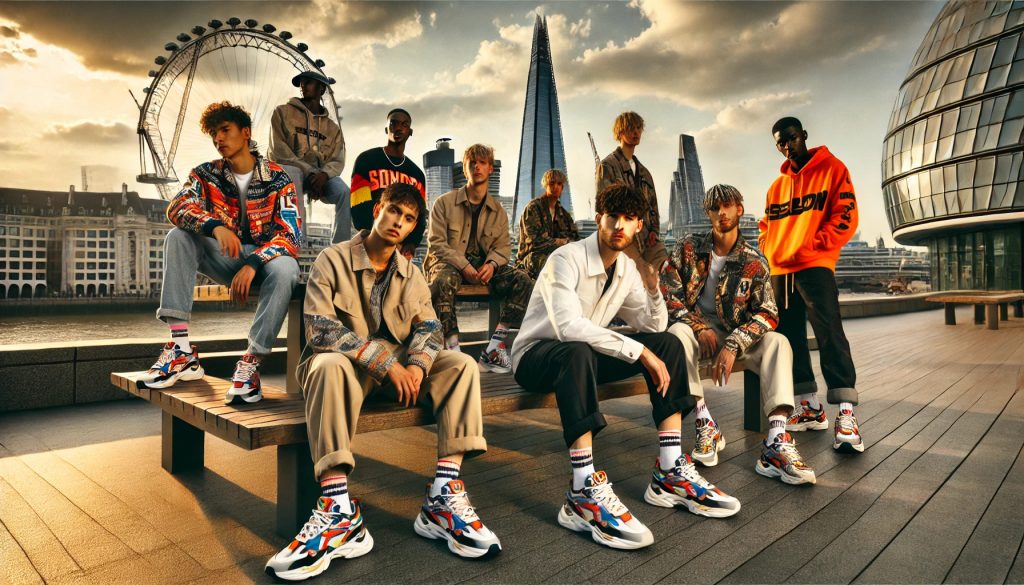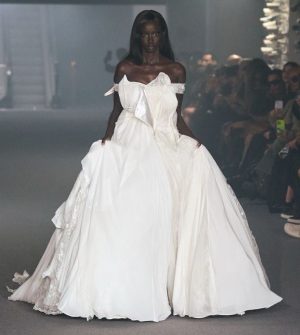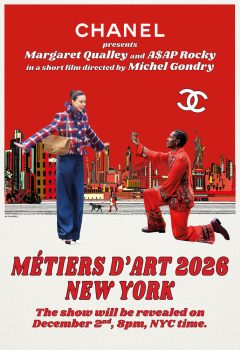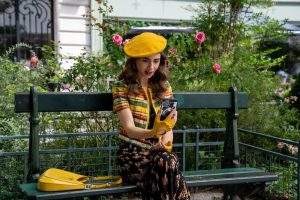Streetwear has grown from a niche subculture to one of the most influential movements, with the global streetwear market size valued at USD 325.28 billion in 2023 and projected to reach USD 637.13 billion by 2032, per Fortune Business Insights.

Image: A Bathing Ape
Rooted in the skateboarding, hip-hop, and urban street cultures of the 1980s and 1990s, streetwear initially focused on comfortable, functional clothing. Per Vogue: “The term first rose to prominence when surfboard designer Shawn Stussy started selling printed T-shirts with his trademark signature in 1980s California. A decade later, James Jebbia started Supreme in New York…
… Clothing inspired by skateboarding culture was adopted by hip-hop artists like Run DMC and Puff Daddy, and that’s where streetwear continues to draw its lifeblood—not just in terms of patronage, but for counterculture credibility… A crucial aspect that lends streetwear legitimacy is authenticity—the fact that it drew from music, art, counterculture and, often, racial codes…” Its uncompromising attitude toward design aesthetics and quality won the streetwear brand a CFDA Award in 2018.
TABLE OF CONTENTS
- The Rise Of Streetwear
- Luxury and active-wear brands integrate streetwear aesthetics
- Streetwear Influencers
- 5 celebrity streetwear brands on the celebrity zeitgeist
- Incorporating Streetwear Aesthetics into Your Daily Wardrobe
The Rise Of Streetwear
The rise of streetwear began with pioneers like Shawn Stussy, the founder of iconic fashion brand Stüssy, and James Jebbia, the mastermind behind Supreme. These brands brought a unique mix of skate culture, music influences, and bold graphics to the forefront of fashion. Supreme, in particular, redefined streetwear by mastering the art of exclusivity. Limited-edition drops, also known as “hype releases,” created a frenzy among fans, making Supreme not just a clothing brand but a cultural phenomenon.
Per BoF: “The founder of what is sometimes dubbed ‘the Chanel of streetwear,’ he has attracted a global cult following for his skateboarding-inspired brand… Produced in limited editions, Jebbia regularly collaborates with mainstream brands such as Comme des Garçons, Levi’s, Vans and Louis Vuitton… These partnerships have helped propel the brand’s iconic status amongst youth counter-culture.”

Nike X Ambush
In November 2020, VF Corporation announced that they agreed to buy Supreme in an all-cash deal for $2.1 billion. VF Corporation bought out investors Carlyle Group and Goode Partners LLC, as well as founder James Jebbia. Supreme was then sold to the eyewear company and Ray-Ban owner, EssilorLuxottica, in July 2024 for a reported $1.5 billion.
However, streetwear has undergone significant transformations since. What started as a grassroots movement rooted in subcultures has now become a global fashion staple. Early streetwear focused on bold graphics, oversized fits, and slogans that resonated with youth rebellion. By the 2000s, brands like A Bathing Ape (BAPE) and The Hundreds began incorporating high-quality materials and limited-edition designs.
Cult streetwear brand A Bathing Ape is a significant part of the streetwear aesthetic in fashion history. Founded by Tomoaki Nagao in Ura-Harajuku, Tokyo, the brand is a symbol of street fashion since its establishment in 1993, dominating the scene with iconic designs, original patterns and characters such as “Ape Head,” “Shark Hoodie” and “Baby Milo.” A Bathing Ape now has stores in Japan, the United States, the United Kingdom, France, China, and other Asian countries.
Luxury and active-wear brands integrate streetwear aesthetics

Louis Vuitton X Supreme
Over the decades, streetwear has evolved into a global phenomenon, with luxury fashion brands Gucci, Balenciaga, and Louis Vuitton embracing streetwear elements to create hybrid collections that cater to both mass and luxury audiences. The rise of influencer culture also played a pivotal role in popularising streetwear worldwide.
Collaborations have also been instrumental in the growth of streetwear. One of the most notable examples is the partnership between Supreme and Louis Vuitton in 2017, which blurred the line between streetwear and high fashion.
Per Vogue: “When Kim Jones, the then artistic director of menswear at Louis Vuitton, launched the Supreme X Louis Vuitton collaboration in the latter’s autumn winter 2017-18 runway, he broke the internet. While Supreme loyalists were quick to call the label a sell-out, the outrage soon faded. Today, pieces from the collection are coveted like rare Birkins…”
The 2014 launch of Adidas Yeezy, Kanye West’s collaboration with the German athletic brand, introduced a nude palette not associated with streetwear. An ardent champion of streetwear, West was also one of the early adopters of Vetements as well as Givenchy’s Rottweiler T-shirts.
In recent years, sustainability and inclusivity have become central to streetwear’s evolution. Emerging brands like Pangaia and Noah prioritise eco-friendly production while others emphasise diversity in their campaigns. Additionally, the line between streetwear and luxury continues to blur. Collections by brands like Balenciaga now feature streetwear staples like hoodies and sneakers albeit with elevated tailoring and premium fabrics. As a result, streetwear has expanded its reach beyond youth culture and is now embraced by people of all ages and backgrounds.
Despite this digital-driven globalisation, the soul of streetwear culture remains grounded in physical experience. The thrill of the hunt and the power of community are preserved in dedicated retail space, from iconic flagship stores to niche boutiques. These cultural hubs foster local identity within the global scene where enthusiasts can connect and discover pieces, like the racing-inspired items found at online shops such as Strictly Wild.
Streetwear Influencers
Streetwear influencers have become pivotal in shaping trends, deftly combining fashion with culture, and inspiring millions on social media apps like Instagram. Among the notable names in the streetwear scene is six-year-old Coco (@coco_pinkprincess), whose unique style has captivated fans worldwide. Her playful and edgy streetwear layers bold patterns and colours. Coco’s rise as a child influencer redefined age boundaries in streetwear culture and proves that individuality transcends generations, earning her collaborations with top-tier brands.
Teen influencer Leo Mandela, known by his handle @gullyguyleo, represents a generation of style-savvy youth who embody streetwear’s rebellious essence. Leo’s curated outfits—from oversized hoodies to eye-catching sneakers—have made him a beloved figure among both streetwear enthusiasts and fashion brands. His ability to mix high-end pieces with street staples reflects the modern evolution of streetwear, where luxury meets authenticity. Brands frequently turn to Leo for his ability to make experimental fashion choices relatable and aspirational to his followers.
Another prominent name is model Luka Sabbat (@lukasabbat), who effortlessly bridges the gap between streetwear and high fashion. Luka’s style is a laid-back sophisticated aesthetic, combining statement streetwear pieces with a sleek edge. His role as an influencer goes beyond just clothes—he has become a cultural icon who collaborates with major brands and contributes to creative projects in art, film, and design. Loved by both fans and industry insiders, Luka’s influence is a testament to streetwear’s power to transcend clothing, becoming a lifestyle that connects people worldwide through creativity and self-expression.
5 Streetwear brands in the celebrity zeitgeist

Ami — the brainchild of Alexandre Mattiussi
- A Bathing Ape — Founded in Harajuku by Nigo, the brand is popular for its graphics and typography, which the creative director would later bring to Kenzo as the luxury brand’s artistic director. The Japanese brand is one of the original streetwear icons, with deep connections to hip-hop and street culture, and has acquired a roster of A-list clientele, with Pharrell Williams wearing loos from each collection. Bape also has key high-fashion collaborations including Comme des Garçons.
- Aimé Leon Dore — Even though Teddy Santis’ brand, based in Queens, New York, is less than a decade in existence, it’s achieved a lot. Inspired by hip-hop, basketball, and prep-infused normcore, the collections are a little on the pricier side. Hailey Bieber and Joe Jonas are just a few names that rock ALD, with the brand’s New Balance collaboration being a popular choice among the sneaker-verse.
- Ambush — Founded in 2008 by Korean-American fashion designer Yoon Ahn, the Tokyo-based label began as an experimental jewellery line recognised for its pop art-inspired designs that were popular with K-pop stars like Big Bang and 2NE1. The brand made its Paris debut in 2015 and within a year Jay-Z and Lady Gaga started rocking Ambush. In 2017 it was selected as one of the top eight finalists for the LVMH Prize.
- Ami — The brainchild of Alexandre Mattiussi, the label was founded in Paris in 2011, but it wasn’t until 2018 when it became sought-after thanks to an iconic collection that featured men’s pieces reworked to fit a traditional women’s aesthetic. Few know that Alexandre Mattiussi founded AMI after years in Parisian couture houses, where he perfected his skill in men’s savoir-faire.
- Arc’teryx — Once a brand designed for professional mountaineers and hardcore explorers, Drake and Frank Ocean are big fans of their outerwear pieces, and the late Virgil Abloh was often spotted rocking coats from Arcy too.
Incorporating Streetwear Aesthetics into Your Daily Wardrobe

Streetwear elements are easy to integrate in our daily wardrobe
- How can I start incorporating streetwear into my wardrobe?
Start with versatile staples like graphic t-shirts, hoodies, sneakers, and joggers. Pair them with neutral or monochrome pieces for a casual yet stylish look.
- Are there streetwear pieces suitable for work settings?
Yes, streetwear can be styled for work with tailored joggers, minimalist sneakers, and structured hoodies layered under blazers.
- How do I style oversized streetwear pieces without looking sloppy?
Balance oversized tops with fitted bottoms, or vice versa. For example, wear an oversized hoodie with slim-fit jeans or tapered joggers.
- What’s the key to building a streetwear wardrobe?
Focus on quality over quantity. Invest in key pieces like sneakers, graphic tees, and outerwear that can be mixed and matched effortlessly.
- Are streetwear brands affordable?
Many streetwear brands, like Carhartt WIP and Vans, offer affordable options, while luxury collaborations may cost more. Shop within your budget and prioritize versatility.
- Can women wear streetwear?
Absolutely! Streetwear is gender-neutral and offers something for everyone. Many brands, like Fear of God Essentials and Nike, design unisex collections.
- How do I accessorise streetwear outfits?
Incorporate caps, bucket hats, backpacks, or bold jewelry to complement your streetwear look. A statement pair of sunglasses can also elevate your style.
- Are sneakers the only footwear option for streetwear?
No, while sneakers are a staple, boots (like Timberlands) or slides can also work, depending on the season and outfit.
- How can I experiment with colors in streetwear?
Start with neutrals like black, white, and gray, then introduce bold colors or prints with a single statement piece, such as a jacket or sneakers.
- Can vintage pieces be part of a streetwear look?
Yes, vintage finds like retro sneakers or thrifted graphic tees add character and uniqueness to your streetwear style.
Streetwear is not just a fashion trend; it’s a cultural movement that continues to evolve and redefine itself. As it adapts to the demands of a more sustainable and inclusive future, its influence is likely to remain as strong as ever. Whether you’re a long-time enthusiast or a newcomer, streetwear offers countless ways to express your individuality.

Jasmeen Dugal is Associate Editor at FashionABC, contributing her insights on fashion, technology, and sustainability. She brings with herself more than two decades of editorial experience, working for national newspapers and luxury magazines in India.
Jasmeen Dugal has worked with exchange4media as a senior writer contributing articles on the country’s advertising and marketing movements, and then with Condenast India as Net Editor where she helmed Vogue India’s official website in terms of design, layout and daily content. Besides this, she is also an entrepreneur running her own luxury portal, Explosivefashion, which highlights the latest in luxury fashion and hospitality.











